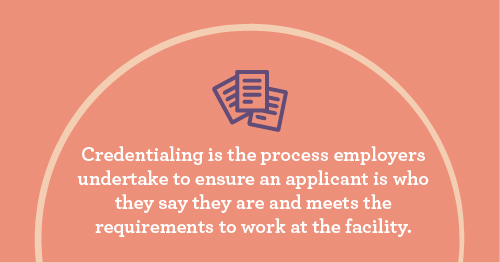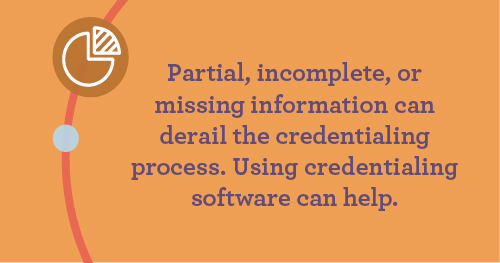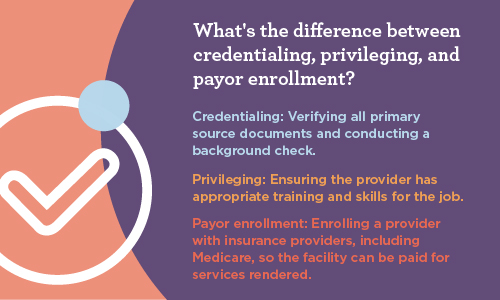This resource is an introduction to physician and advance practice provider credentialing for a healthcare facility. It will help newcomers to the healthcare industry become familiar with basic credentialing terminology, how the credentialing process works, and who the key stakeholders are.
What is credentialing?
Credentialing is the first step to putting a physician to work at a facility. It’s how employers ensure the applicant is who they say they are. Are the credentials they have provided legitimate? Do they meet the requirements to be on staff at your facility?

The process includes verifying information such as:
- Education and training
- Residency
- Licenses
- Specialty certificates
- Qualifications
- Career history
This is done through a process known as primary source verification (PSV), where the organization doing the credentialing reaches out to the original source to verify that the information is accurate as represented by the applicant.
Where does credentialing start?
Although the credentialing process is initiated by the credentialing organization, it ultimately starts with the provider. They are responsible for getting the required information to the person who will be overseeing the process. In most healthcare organizations, this will be a designated credentialing expert, such as a medical staff coordinator for larger facilities or a practice manager or business office manager for smaller facilities and private practices.
What can derail the credentialing process?
One of the biggest challenges faced in credentialing is when applicants provide incomplete information. When the credentialing expert receives partial, incomplete, or missing information, it creates a lot of back and forth, which can be very time consuming.

Some organizations use credentialing software to help with this process by archiving information, so the provider only has to give it once regardless of how many times it’s needed for credentialing, privileging, or payor enrollment. However, the provider is still responsible for submitting complete information, and the credentialing expert is responsible for keeping it organized so the process can move forward.
Review by key stakeholders
Once a provider’s information has been collected and verified, it is sent for review by the medical staff committee or other governing body. This committee may differ from facility to facility, depending on size, but it typically consists of multiple members. In the case of a hospital or larger facilities, the medical staff committee usually consists of department heads.
For smaller healthcare or private-practice organizations, the process will typically be overseen by human resources or a practice manager administrator.

Privileging and payor enrollment
In addition to credentialing, a provider may also need to go through privileging and payor enrollment. The differences between these processes can be confusing, and sometimes it’s assumed that once one of the three steps has been met, the physician is ready to practice at your facility. Credentialing and privileging are the two processes that most often get confused.

At their most basic level, the three processes are:
Credentialing: Generally refers to primary source credentialing (background check), also known as primary source verification.
Privileging: Making sure the provider has the appropriate training and experience to meet the minimum requirements and all authorizations to carry out requested procedures at a specific facility.
Payor enrollment: The process by which a medical provider gets entered into insurance plans, networks, Medicare, and Medicaid, so the provider and facility can be paid for services rendered to patients by that provider.
Don't lose money on your locums: Learn how to bill for locum tenens services
Background checks
A crucial step in the credentialing process that can’t be overlooked is a background check — even if the applicant’s CV looks impeccable. The three most frequently used data banks for background checks on healthcare providers are:
- National Practitioner Data Bank (NPDB)
- The Board Action Data Bank of the Federation of State Medical Boards (FSMB)
- American Medical Association Physician Masterfile (AMA)
Background checks help protect your patients from incompetent medical practitioners and will reveal any negative sanctions taken against specific physicians. It’s an important way to make sure you’ve done your due diligence, since some physicians fail to include this critical information in their applications.
Credentialing tools
For many facilities, credentialing is a manual process, which can be time consuming and is often prone to errors and redundancies. However, credentialing software tools can help reduce errors, eliminate redundancy, and speed up the credentialing process. They can also help organizations ensure providers remain compliant so they can continue to practice and be billable. For example, automated alerts can notify the medical staff coordinator or HR director that a license needs to be renewed by a certain date.
Software tools can also improve visibility into the credentialing process, making it easier to check on progress and spot potential risks that could prevent a provider from going to work.
Additional resources
For more information on the credentialing process, the following resources may be helpful:
 Blog
Blog